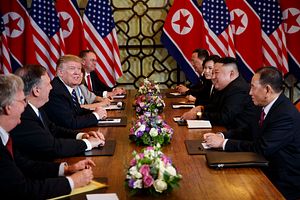Coming on the heels of the Singapore summit, the second meeting between U.S. President Donald Trump and North Korean leader Kim Jong Un in Hanoi, Vietnam was too much, too soon. The outcome was predictable. Even the preparatory, working-level meetings leading up to the summit in Vietnam proved largely nonproductive – a harbinger of things to come.
While the Hanoi summit gave neither party the outcome it had hoped for, it provided important insights into the priorities and blind spots of each country. These insights will likely prove useful, even if Hanoi marks the end of the road for bilateral negotiations.
What Happened in Singapore and Hanoi
The June 2018 Singapore summit was, unquestionably, historic. It marked the first time a sitting U.S. president ever met a North Korean leader face-to-face. But for all of its historic significance, it proved to be a let-down, albeit a let-down with some illusion of success. Prior to the meeting, negotiations resulted in the return of the four Americans previously held captive by Pyongyang’s leadership – a noteworthy, though not unprecedented, concession.
While nothing of substance emerged from the summit itself, it did result in a joint statement in which Trump and Kim agreed to improve relations, build a peace regime, commit to complete denuclearization, and restart efforts to return the remains of American POWs from the Korean War.
Yet, within a few hours of the signing of the Singapore declaration, things began to unravel. In the press conference following the summit, Trump blindsided allies, the Pentagon, and U.S. forces in Korea by temporarily suspending joint military exercises with South Korea. Trump described the defensive preparedness exercises as provocative and costly. Since the Singapore summit, the United States and South Korea have subsequently cancelled at least nine joint military exercises and placed constraints on several others.
Trump also waved off concerns regarding human rights – in spite of the fact that Kim’s regime holds an estimated 80,000 to 120,000 political prisoners. Instead, he flattered the North Korean leader, calling him honorable and crediting him with loving his people and wanting what is best for them. This was shocking, considering the president’s strong condemnations of Pyongyang’s human rights violations in 2017 and earlier in 2018.
The mirage of success in Singapore faded quickly as it became clear that neither the United States nor North Korea agreed on what “complete denuclearization” means. North Korea claims it means denuclearization of the entire Korean Peninsula, including U.S. nuclear assets that protect South Korea under their alliance arrangement. Meanwhile, the United States insists it means unilateral, North Korean disarmament, as required by 11 UN resolutions. Definitional issues continue to haunt negotiations.
































